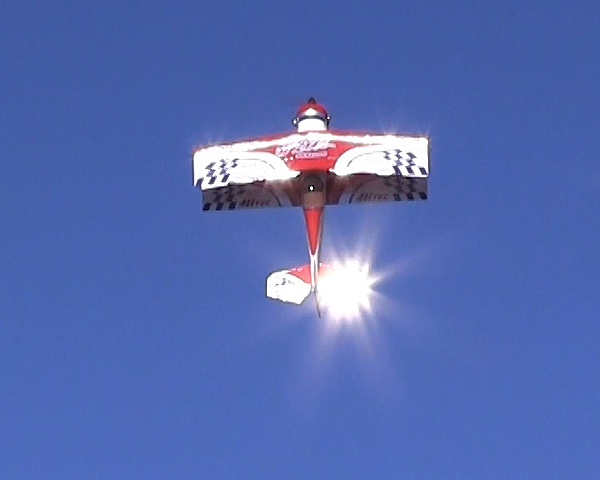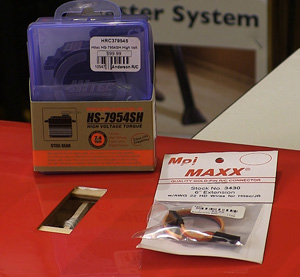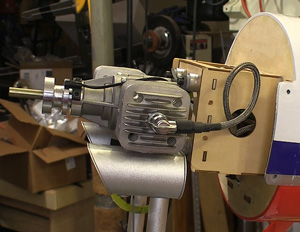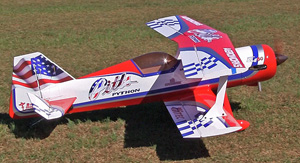



A great biplane to fly!
Text, photos and video by Tom Hintz
Posted – 10-28-2014
Back when I flew RC the first time, over 25 years ago I flew a ¼-scale Pitts and a ¼-scale Christian Eagle. I loved those planes because of how aerobatic they were. Another strong point was how they looked in the air. There is something about a biplane that just looks right in the sky.
While looking for a new plane to “fill out” my personal air force I didn’t have to do much pondering. Once again Aeroworks was at the head of the class, this time with their Aeroworks 50cc Pitts Python ARF-QB.
The Aeroworks 50cc Pitts Python ARF-QB has an upper wing span of 70- inches with the bottom wing measuring 68-inches. That gives this plane a wing area of 1725-sq.-in. and a wing loading of just 24.06-oz per square foot. I would find that the Aeroworks 50cc Pitts Python ARF-QB flies lighter than that wing loading suggests.
The fuselage is 72”-long from the tip of the spinner to the end of the rudder. The Aeroworks 50cc Pitts Python ARF-QB has a cowl that is 9.5”-wide which gives me lots of engine choices. The cowl has a custom baffle that looks like a radial engine. You can open sections of the replica baffle to best cool your engine. Overall weight of the Aeroworks 50cc Pitts Python ARF-QB should come in at 17 to 18-lbs.

Aeroworks suggests a 50cc gas engine but am going to hang a DLE-60 twin on the front. The Aeroworks 50cc Pitts Python ARF-QB has a round cowl and it will not hurt my feelings at all if the cylinder heads stick out of either side. Both wings are one-piece and designed to be easily installed at the field quickly.
The Aeroworks 50cc Pitts Python ARF-QB airframe is typical Aeroworks, very light and very strong. The main landing gear is painted 7075 aluminum as is the steerable tail wheel assembly. The painted fiberglass wheel pants are read to bolt on. The plane is covered with UTRACOTE™ so replacement covering is easy to get. Aeroworks includes sections of covering with the kit for normal repairs. You also get a strip of clear covering to seal the hinge gaps.
One of the things Aeroworks is known for is the very complete, high quality SAE hardware package that comes with their planes. The true turnbuckle control rod links are tough and make dialing in the control surfaces simple, fast and very accurate.
The wings have one servo per aileron with those hinges installed and glued. You do have to install the vertical and horizontal stabs. You also have to glue in the provided pin-style hinges on the elevator and rudder but with everything ready for you this is an easy task. You also get a set of pre-made, tail flying wires that just bolt into place using re-drilled holes.
The Aeroworks 50cc Pitts Python ARF-QB uses dual elevators and a pull-pull rudder with nice hardware included for that as well. All of the control surfaces are double beveled so you can dial in outright scary throws if you so desire. When you see the size of the control surfaces having a fall back reduced dual rate dialed in will seem like a good idea.
The engine box comes assembled and installed (and fuel proofed) with the correct thrust line built in. Aeroworks supplies laser marked engine mounting templates that cover lots of major engine manufacturers. To help with the setup Aeroworks includes a custom throw meter plus a rudder deflection gauge.

Those who already own an Aeroworks plane in the past will recognize the tough double boxing and lots of bubble wrap. Aeroworks is intent on getting the planes to you unscathed as my Aeroworks 50cc Pitts Python ARF-QB did. Covering reacts to temperature and humidity changes so it should be no surprise that a trip halfway around the world will produce some wrinkles. Get out the covering iron and go over all of the covering. This is a big plane and I did find some wrinkles but it still took me less than half an hour to pretty everything up.
All four ailerons get their own servos, connected with double steel control horns and turnbuckle rods. Each control horn half is held in place by three screws and each has three connecting points for the linkage for lots of throw tweaking.
The vertical and horizontal stabilizers have to be epoxied in place but the way they are made this is a very easy task. Because of this assembly sequence we have to epoxy the pin hinges in the elevators and rudder but again, not a big deal. I kind of like gluing the hinges in myself just for the peace of mind even though I’ve never had an issue with an Aeroworks installed hinge.
All of the Aeroworks 50cc Pitts Python ARF-QB assembly went smoothly with no fit or finish issues. The biggest problem I encountered was placing the HiTec HS-430BH high voltage throttle servo where a carbon fiber pushrod could run to it directly. I installed the DLE 60-Twin upside down as most do. The Aeroworks 50cc Pitts Python ARF-QB has a nice area for mounting throttle servos but my configuration missed that. I used one of the included servo boxes attached to a piece of light ply to hang the assembly on the side of the fuselage bay. Problem solved.
While it is probably a bit of overkill I used HiTec HS-7954SH high voltage servos on all ailerons, elevators and rudder. The Aeroworks 50cc Pitts Python ARF-QB manual calls for a minimum of 180-inch-ounce torque and the HiTec HS-7954SH double that and then some. I don’t like it when servos struggle to keep up.
To power the servos and everything else I am using a Smart-Fly PowerExpander Sport Plus that delivers the full 7.4V from a pair of Glacier 7.4V, 5000mAh LiPo packs to the servos. It also sends a heavily filtered 5V to the receiver. This board has full battery isolation capability so a problem with one pack will not take out the other one. This system also draws power from the battery with the highest charge so they both are drawn down equally.
The Smart-Fly PowerExpander Sport Plus also has a fiber optic ignition kill system built in. This system keeps the entire ignition wiring up front and totally isolated from the receiver and everything else. A unit mounted up front s connected only by a fiber optic cable and allows me to shut the ignition off from the transmitter. The DLE ignition module is powered by a Glacier 7.4V, 2600mAh LiPo pack which is also overkill but I like to fly several times in a day and this just makes sure that the ignition is getting everything it needs all day.
The Aeroworks 50cc Pitts Python ARF-QB is advertised to weigh between 17 and 18lbs and mine came in, all up except gas splitting the 17-1/2 lb. mark on our scale, the fully assembled plane standing on the carbon fiber spinner. The CG is also almost dead on as I built it, hanging tail down just a little, certainly less than 1 inch. Remember that I am running a 32-ounce Fortitude tank so will be carrying a little more fuel than most, even after a 10 minute flight. I expect that my Aeroworks 50cc Pitts Python ARF-QB will actually be just a tick nose heavy if not neutral in terms of balance when in flight.

Setup is made way easier by the included pitch gauge and a card stock rudder throw gauge that lets you be accurate with both deflections without having to shim the plane up on its side, twice. The pitch gauge is simple but as long as the laws of gravity remain in effect, it will be dead on accurate. It also lets you set both up and down on an elevator or aileron without having to touch the gauge. With today’s computer radios we can dial in two or three rate settings to tame the Aeroworks 50cc Pitts Python ARF-QB down for landing or to let you get your feet wet before going to full throws.
To some bi planes still suffer from a reputation earned years ago for being hard to fly. When I flew a ¼-scale Pitts and Christian Eagle 25 years ago the construction and materials of the period translated to what would be scary wing loading numbers today. My ¼-scale Pitts back then that weighed in at a solid 29 pounds and while it was beautiful in the air and quite aerobatic it was a bit like flying a truck. I had to always focus on energy because as you slowed virtually any control input had the potential to initiate a snap roll. Many of those early ¼-scale bi planes were lost exactly that way. Contrast that to the bigger Aeroworks 50cc Pitts Python ARF-QB at 17-1/2lbs and much of its remarkable performance is explained.
I don’t want this review to sound like a commercial but the Aeroworks 50cc Pitts Python ARF-QB is simply a spectacular airplane in terms of appearance and flight performance. From the moment this plane lifted off I was impressed with how light it flies and its stability. On the maiden flight I had climbed to about 30 feet when I let go of the sticks and just watched the Aeroworks 50cc Pitts Python ARF-QB continue climbing out nearly straight and true all on its own. During the maiden I added two clicks down and one right and that was it for trim. Now many flights later those trims remain nearly untouched. In a good amount of wind I found that putting a click or two of down helps the Aeroworks 50cc Pitts Python ARF-QB settle back to earth.
The only heart-in-the-throat moment during the maiden flight came soon after takeoff when I turned it down wind at full throttle, on high rates and foolishly pushed the ailerons all the way left – begin the aileron education here. Current Aeroworks 50cc Pitts Python ARF-QB owners on the forums had warned me to expect a high roll rate and that turned out to be an understatement of massive proportions. I have never seen wings rotate so fast that they actually blur. Plus I have never heard a collective “wow” from everyone behind me when they also lost track of the rotations. But let go of the stick and the Aeroworks 50cc Pitts Python ARF-QB instantly stops the roll when the stick hits center.
Flying inverted on a 45-dgree up line produced a no discernible arc telling me that the Pitts likes the factory-specified CG location. I always shoot approaches early in a maiden fight to get a feel for landing the plane and after the roll experience I was little apprehensive. Those concerns proved to be unwarranted as on medium rates the Aeroworks 50cc Pitts Python ARF-QB returns to the runway easily with rock solid stability. Being a bi plane landing this Pitts without a bounce is challenging but can be done. This plane also slows nicely when you reduce throttle. I was making relatively steep approaches because of the wind direction and the Pitts maintained speed until I leveled it out near the ground where it slows quickly to a good landing speed. I should note that for the maiden flight we had rather brisk, gusty winds but controlling the Pitts during landing was far easier than I expected.
Through the remaining flights of that first day I explored things like stall characteristics and how the Aeroworks 50cc Pitts Python ARF-QB handles upright and inverted flat spins, snap rolls, hovering and more. It is important to note that the physics of having a second wing remain. Get carried away with rudder and the Aeroworks 50cc Pitts Python ARF-QB will try to tuck a wing under itself but that is easily corrected and can be prevented by using the amount of rudder needed and not just banging the stick as I did when I discovered this tendency.
All of the control surfaces have a lot of authority but the ailerons are King on the Aeroworks 50cc Pitts Python ARF-QB. I noted that in some tumbles it seemed like the ailerons were overpowering the rudder and elevator and Aeroworks confirmed that when I asked. They suggested trying some lower aileron rates which I have done and they are spot on. I still need to refine the setting but using one of my dual rate modes to reduce aileron throw helps a bunch. For most flying the ailerons are just fine at normal and high throws. I’m not complaining, just reminding you that there are ways to manipulate control throws to get the Aeroworks 50cc Pitts Python ARF-QB to do some rather spectacular things in the air.
In knife edge flight the Aeroworks 50cc Pitts Python ARF-QB has some coupling - particularly left wing up - because it is a bi plane and the laws of physics remain in effect. Right wing up knife edge flight uses the thrust line of the motor better and has far less coupling. The authority of the ailerons and elevator let you “stick it out” and produce very stable knife edge flight once you get used to how much correction it needs. Of course you can mix a lot of the coupling out but I like to learn to do it with the sticks. Over the years I have flown several Pitts bi planes and the Aeroworks version seems to need less corrective stick inputs to straighten out knife edge flight than with many other designs.
In the first 6 flights I did not find any bad tendencies in how the Aeroworks 50cc Pitts Python ARF-QB handles. In full stalls it does want to drop a wing and fall off but it recovers quickly with just a bit of power. Exiting even hard spins is quick and clean which is reassuring for a “D & 1/2” pilot such as myself. The design of the Aeroworks 50cc Pitts Python ARF-QB allows it to be a pure aerobatic animal yet morph into a puppy for landing.
The Aeroworks 50cc Pitts Python ARF-QB is a relatively fast airplane at full throttle but also handles very well at surprisingly low speeds. With a little practice things like harriers and hovering are well within reach. Though I am awful at hovering, the Aeroworks 50cc Pitts Python ARF-QB seems surprisingly stable when I try to hover it. I need lots more practice but it is obvious that the Aeroworks 50cc Pitts Python ARF-QB wants to hover and goes into the torque roll when you get it straight up and down.
The Aeroworks 50cc Pitts Python ARF-QB is a spectacular plane with a flight envelope larger than any bi plane I have flown. Though certainly not a beginners plane pilots with intermediate and higher piloting skills should have no problem flying the Aeroworks 50cc Pitts Python ARF-QB. This plane has far more capabilities than I have skills but it is making learning many things easier because it flies with such stability.
Another impressive feature of the Aeroworks 50cc Pitts Python ARF-QB is how well the economical DLE 60-twin engine pulls it around. I have flown it with a Vess 23C and (currently) a Vess 24B prop and the plane likes both of them. The light weight of the Aeroworks 50cc Pitts Python ARF-QB makes punching out of a failed hover easy and dependable.
If you like the looks of a bi plane or have flown them in the past it is time to modern up and take a hard look at the Aeroworks 50cc Pitts Python ARF-QB. The kit builds easily, the finished plane flies great and it has all of the classic grace of the bi plane. Only now you get to decide how much of an animal it is in the sky.
To visit the Aeroworks product page – Click Here
Have a comment on this review? –Email Me!